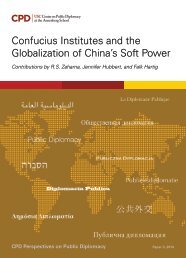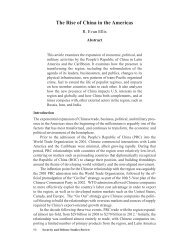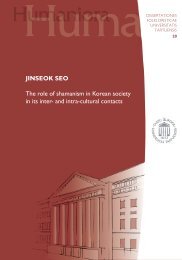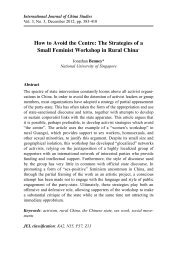JennyChan.PhDThesis.2014.FINAL
JennyChan.PhDThesis.2014.FINAL
JennyChan.PhDThesis.2014.FINAL
Create successful ePaper yourself
Turn your PDF publications into a flip-book with our unique Google optimized e-Paper software.
Chapter 2<br />
The Labor Politics of Global Production<br />
Labor politics begins with the laborers themselves: their geographical<br />
origins, gender, popular culture, educational attainments, work<br />
experiences, and the like. These are the features of a worker’s milieu<br />
that structure lasting traditions of collective action.<br />
—Elizabeth Perry 62<br />
This research, following Elizabeth Perry’s analytical approach, begins with workers’<br />
defense of their own interests and their collective actions. Before the founding of the<br />
Chinese Communist Party in 1921 or the involvement of Marxist intellectuals and<br />
students in labor organizing at the turn of the 20 th century, workers and other socially<br />
subordinate groups (such as peasants) had long created their own traditions and<br />
protest repertories to safeguard their collective interests. 63 This chapter draws on<br />
historical and sociological literature to analyze workers’ subjectivities and persistent<br />
efforts in changing their socio-political and economic conditions.<br />
As China emerged as the “workshop of the world” with a shift of manufacturing<br />
from the developed countries of North American, Europe and East Asia to China and<br />
other developing countries, China has arguably become the “epicenter of world labor<br />
unrest” in the wake of global outsourcing and transnational manufacturing. 64 In<br />
response to growing numbers of labor protests since the early 1990s, the state,<br />
central and local, has attempted to fragment workers’ identities, class interests, and<br />
mobilization efforts, and achieved some degree of success. 65 Workers’ associational<br />
power remains weak, as official trade unions are politically restrained from leading<br />
strikes and protests. Tim Pringle however reminds us: “The absence of independent<br />
trade unions does not automatically preclude working class influence on most<br />
62 Elizabeth J. Perry, 1993, Shanghai on Strike: The Politics of Chinese Labor, Stanford, California:<br />
Stanford University Press, pp. 4-5.<br />
63 Ho-fung Hung, 2011, Protest with Chinese Characteristics: Demonstrations, Riots, and Petitions<br />
in the Mid-Qing Dynasty, New York: Columbia University Press.<br />
64 For discussions on labor politics in the Chinese automobile industry, see Beverly J. Silver and Lu<br />
Zhang, 2009, “China as an Emerging Epicenter of World Labour Unrest,” China and the<br />
Transformation of Global Capitalism, edited by Ho-fung Hung, Baltimore: The Johns Hopkins<br />
University Press, pp. 174-87.<br />
65 Ching Kwan Lee, 2010, “Pathways of Labor Activism,” Chinese Society: Change, Conflict and<br />
Resistance, edited by Elizabeth J. Perry and Mark Selden, London: Routledge, pp. 57-79; Ching<br />
Kwan Lee and Yonghong Zhang, 2013, “The Power of Instability: Unraveling the Microfoundations<br />
of Bargained Authoritarianism in China,” American Journal of Sociology 118(6), pp. 1475-508; Ching<br />
Kwan Lee, 2014, “State and Social Protest,” Daedalus: The Journal of the American Academy of Arts<br />
and Sciences 143(2), pp. 124-34.<br />
22






